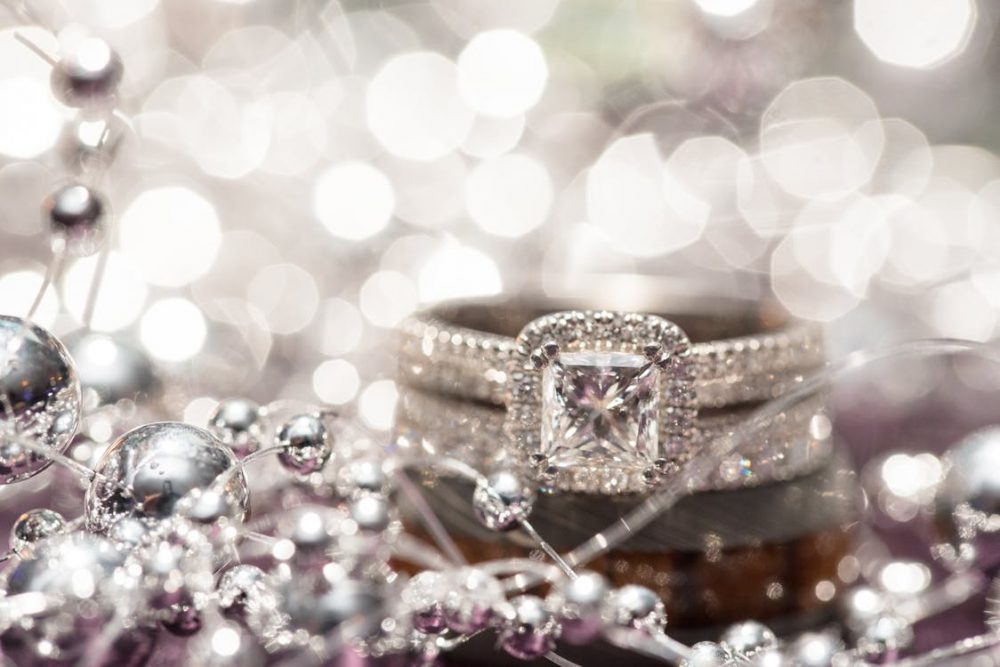Whether you’re heading out to purchase a ring for your fiancé or going shopping together, choosing the perfect engagement ring is no easy task. First of all, your fiancé needs to treasure this item for the rest of their lives (no pressure) and second of all, the ring should represent your relationship and feelings for each other. Perhaps the most difficult task of all is ensuring that the ring fits within your set budgets.
Before you head out on your search, it’s crucial that you get yourself clued up on some of the less common terms around engagement rings. This way you will have a much better idea of what you are looking for and will be able to make well-informed decisions. To help you out, we’ve teamed up with Angelic Diamonds, who make bespoke engagement rings, to translate some of the trickier terms out there.
Guide to engagement ring styles
The style of ring that you choose can affect the arrangement of the main diamond, how it looks when it’s on the finger and where the jewels sit on the ring band. There are eight main styles:
- Solitaire — The simplest style, a solitaire ring features a single stone in the centre of the band.
- Shoulder — This style of ring features a channel of diamonds running down each side (shoulder) of the band, it usually has a larger diamond in the centre too.
- Halo — This is a popular style; a centre diamond is framed with smaller diamonds which makes the centre stone look bigger.
- Three-stone — Said to symbolise the couple’s past, present and future, a three-stone band is often made up of a large diamond which is framed by a smaller diamond on each side.
- Cluster — For this style of ring, smaller diamonds are grouped together to give the appearance of one big diamond.
- Tension — In a tension set ring, the tension of the band keeps the diamond in its place, it often creates a bold and modern look.
- Bezel — In a bezel ring, a thin piece of metal holds the ring in place. You can choose from full bezel ring settings where the diamond is fully circled or partial bezel settings that only cover part of the diamond.
- Vintage — Inspired by antique styles, a vintage engagement ring is designed to look like it’s from centuries ago.
Guide to engagement ring shapes
The next step is choosing the shape – there are a variety of shapes to choose from, however some can be more costly than others.
- Round — This is the most popular cut of diamond and considered to be the most brilliant by many. The stone is cut into a cone shape which allows light to enter the stone.
- Princess – This cut looks as though it’s a square or rectangle but is actually a pyramid shape, this shape is again known for its brilliance.
- Emerald — An Emerald cut diamond is rectangular with rounded corners, designed to highlight the gem’s shine
- Oval — Cut in a similar way to the round diamond, an Oval cut offers more of a contemporary feel.
- Pear — Also known as the teardrop, the Pear cut diamond can be worn either pointing towards or away from the hand.
- Marquise — Cut with an elongated shape and sharp ends, the Marquise diamond gives off a majestic appearance.
- Cushion — Also referred to as a pillow cut diamond, the Cushion shaped diamond can be square or rectangular with larger facets and rounded corners.
- Asscher — Cut in a similar way to an Emerald diamond, an Asscher cut diamond has an octagonal shape and more brilliance.
- Heart — The Heart cut has similar brilliance to the Round cut diamond but is more eye-catching because of its shape, guaranteed to turn heads.
- Radiant — This type of cut has a square shape and rounded corners, similar to the Emerald cut. However, a radiant cut diamond has more brilliance and sparkle.
Guide to the 4Cs
If you’ve opted for a diamond engagement ring, you should understand the 4C’s. These are the four main aspects of the diamond that determine its appearance and cost:
- Cut — The cut of a diamond refers to its symmetry, proportions and polish. It shouldn’t be confused with the shape of the diamond.
- Clarity — This refers to the diamond’s internal features, or ‘inclusions’. Generally speaking, the more inclusions that a ring has, the less appealing it is.
- Colour — Although most diamonds look colourless to the naked eye, if you look closely you might be able to see that there are subtle yellow and brown tones that separate them. Less expensive diamonds are usually the ones with the most of these tones.
- Carat weight — Carat is the unit that diamonds are weighed in. Note that this is different to a Karat which is a measurement of purity in gold.
Guide to additional terms
Some terms are rarer and you might not come across them on your shopping trip, however it’s always best to be prepared. Here are some additional terms:
- Culet — This is the point at the bottom of the diamond, the size and angle of this can affect the diamond’s worth.
- Brilliance — This refers to the appearance of white light in the stone. Light passing through the stone produces this and it’s expertly measured with a Brilliance-Scope.
- Prong — This is a type of setting, also known as the claw. It uses less metal to hold the stone and therefore more light can pass through the diamond.
- Channel — Another setting, a channel secures diamonds in place and sits them flush with the band of the ring.
- Pavé — A pavé setting sets groups of small gems in place and makes the ring appear to sparkle all the way round the band.

